Potrebujeme váš súhlas na využitie jednotlivých dát, aby sa vám okrem iného mohli ukazovať informácie týkajúce sa vašich záujmov. Súhlas udelíte kliknutím na tlačidlo „OK“.
ASTM E2907/E2907M-13
Standard Practice for Examination of Paper Machine Rolls Using Acoustic Emission from Crack Face Rubbing
Automaticky preložený názov:
Štandardná prax pre vyšetrenie papierenského stroja Rolls využitím akustické emisie z Crack Face trenia
NORMA vydaná dňa 1.6.2013
Informácie o norme:
Označenie normy: ASTM E2907/E2907M-13
Poznámka: NEPLATNÁ
Dátum vydania normy: 1.6.2013
Kód tovaru: NS-46246
Počet strán: 7
Približná hmotnosť: 21 g (0.05 libier)
Krajina: Americká technická norma
Kategória: Technické normy ASTM
Kategórie - podobné normy:
Hluk působený stroji a zařízeními
Zařízení pro papírenský průmysl
Anotácia textu normy ASTM E2907/E2907M-13 :
Keywords:
acoustic emission, paper machine rolls, fatigue crack growth, ICS Number Code 17.140.20 (Noise emitted by machines and equipment), 85.100 (Equipment for the paper industry)
Doplňujúce informácie
| Significance and Use | ||||||||||||||||||||
|
5.1 Paper machine rolls can range in size from 2.4 to 9 m [8 to 30 ft] long, with a shell thickness of from 12.5 to 75 mm [0.5 to 3 in.,] and 300 to 1200 mm [12 to 48 in.] diameter. Depending on purpose, paper machine rolls can weigh as little as 60 000 kg [13 000 lb] to as much as 27 500 kg [60 000 lb]. 5.2 If indications are found during this procedure it can be repeated, with additional sensors to refine source location accuracy. 5.3 Removal of rolls for traditional NDT examination may be impractical and may not be sensitive enough to locate small defects. 5.4 Traditional AE examination, whereby the roll is subjected to load greater than service load to detect crack extension, risks damage to the roll and is best employed as a follow-up NDT examination. 5.5 Manual rotation through a full revolution subjects existing cracks to tensile and compressive forces which can open and close existing cracks, and cause friction at the crack surfaces. 5.6 Excess background noise (overhead cranes, nearby maintenance activities) may distort AE data or render it useless. Users must be aware of the following common sources of background noise: bearing noise (lack of lubrication, spalling, and so forth), mechanical contact with the roll by other objects, electromagnetic interference (EMI) and radio frequency interference (RFI) from nearby broadcasting facilities and from other sources. This practice should not be used if background noise cannot be eliminated or controlled. 5.7 Other Non-destructive test methods may be used to evaluate the significance of AE indications. Traditional AE has been used to confirm the existence of the AE indication and fine tune the location. Magnetic particle, ultrasonic and radiographic examinations have been used to establish the position, depth and dimensions of the indication. Procedures for using other NDT methods are beyond the scope of this practice. |
||||||||||||||||||||
| 1. Scope | ||||||||||||||||||||
|
1.1 This practice provides guidelines for acoustic emission (AE) examinations of non-pressure, paper machine rolls. 1.2 This practice utilizes a slow rotation of the roll to produce a full load cycle where load is provided by the weight of the roll suspended from its bearings or other journal support mechanism(s). 1.3 This practice is used for detection of cracks and other discontinuities in rolls that produce frictional acoustic emission during rotation. 1.4 The AE measurements are used to detect or locate emission sources, or both. Other nondestructive test (NDT) methods must be used to evaluate the significance of AE sources. Procedures for other NDT techniques are beyond the scope of this practice. See Note 1. 1.5 The values stated in either SI
units or inch-pound units are to be regarded separately as
standard. The values stated in each system may not be exact
equivalents; therefore, each system shall be used independently of
the other. Combining values from the two systems may result in
non-conformance with the standards.
1.6 This standard does not purport to address all of the safety concerns, if any, associated with its use. It is the responsibility of the user of this standard to establish appropriate safety and health practices and determine the applicability of regulatory limitations prior to use. Specific precautionary statements are given in Section 8. |
||||||||||||||||||||
| 2. Referenced Documents | ||||||||||||||||||||
|
Podobné normy:
Historická
15.6.2012
Historická
1.4.2009
Historická
15.6.2012
Historická
1.1.2010
Historická
15.6.2012
Historická
1.8.2014



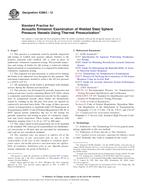 ASTM E2863-12
ASTM E2863-12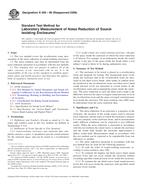 ASTM E596-96(2009)..
ASTM E596-96(2009)..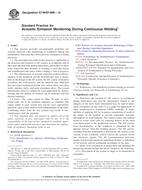 ASTM E749/E749M-12..
ASTM E749/E749M-12..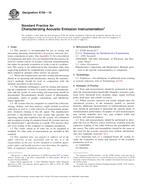 ASTM E750-10
ASTM E750-10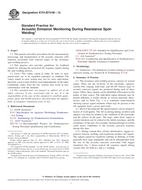 ASTM E751/E751M-12..
ASTM E751/E751M-12..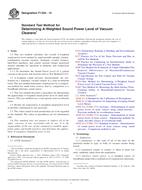 ASTM F1334-14
ASTM F1334-14
 Cookies
Cookies
